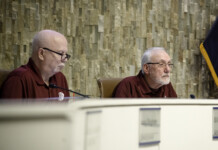Thursday night’s Transit Feasibility meeting in Maricopa presented a plan for future transit options in the city, shaped upon the findings of a transit study done in 2006.
The much anticipated sequel to September’s feasibility review, last night’s implementation plan illustrated the need for a commuter bus system that will originate in Maricopa, using a park and ride method.
“We already know people are driving to the Pecos and 40th park and ride lot and getting on a bus, so let’s catch them before they get onto the 347,” said Amy Ford, a consultant from Parsons Brinckerhoff, who presented the findings.
She also said the need for mass transit stems from the considerable dissatisfaction expressed by Maricopa residents with the SR 347.
“I’m going to point out the obvious: SR 347 is the problem that we heard about the most,” she said. “If you get in an accident, that’s it. You’re going to be locked in that parking lot for hours.”
The study also suggested the need for three major routes from Maricopa into Maricopa County, specifically the downtown Phoenix area, downtown Tempe and the southeast portion of Chandler. These are the proposed routes because the majority of Maricopa residents who are employed outside of Maricopa work in one of the three areas.
This point sparked concern from residents attending, who said they continue to wonder when the number of jobs available inside the city limits will increase.
Brent Billingsley, Transportation Manager for the City of Maricopa, responded to this by saying the three major tenets in solving the transportation issues were reducing the number of trips made out of Maricopa by means of a mass transit system, exploring alternate routes and increasing the number of internal trips by adding jobs available within Maricopa.

Transportation Manager Brent Billingsley, at an earlier transportation meeting, had the same message: Maricopa needs a mass transit system, alternative routes out of the city and more local jobs to reduce external travel.
Ford proposed a phased approach to implementing her recommendations, starting with the city hiring a transit coordinator, who will not only gather the necessary information for the system but will also dedicate a large amount of time to publicizing that information.
Next, she recommended a test bus service used to evaluate whether or not they can get those ‘choice riders’ out of their cars and onto the bus.
Matt Carpenter, an Action Planning Program Manager with ADOT, also pointed out that the Governor has given ADOT a 90-day deadline to come up with alternative plans and ideas for possible commuter solutions, including a light rail connecting Pinal and Maricopa counties.
The most immediate step, however, is applying for funding for the busing system.
The City of Maricopa will apply for a federal grant designed specifically for rural areas to create connectivity with metro areas. Funding from this program will assist in purchasing infrastructure, employment and operation of the service.
Maricopa residents were also encouraged to attend the State Transportation Board meeting on February 16th, which will be hosted in Maricopa.
“What an opportunity to voice our concerns . . .” Billingsley said. “They wouldn’t be coming here if Maricopa wasn’t on the forefront and on their minds.”

![Chicago pizzeria to start slinging pies in days An image of dishes served at Vero Chicago Pizza, which includes their buttercrust pan and Chicago-style pizzas. [Vero Chicago Pizza]](https://www.inmaricopa.com/wp-content/uploads/2024/05/vero-051424-vero-chicago-pizza-01-218x150.jpg)









![Traffic change to reduce backup at Villages intersection The intersection at Butterfield Parkway and West Edison Road on May 10, 2024. [Brian Petersheim Jr.]](https://www.inmaricopa.com/wp-content/uploads/2024/05/PJ_5644-218x150.jpg)
![Copa Kitchen celebrates grand opening Customers Tonia and Gavin Belanger sit for dinner during the Asian Seoul's Copa Kitchen grand opening on May 8, 2024. [Monica D. Spencer]](https://www.inmaricopa.com/wp-content/uploads/2024/05/spencer-050824-asian-seoul-copa-kitchen-grand-opening-web-218x150.jpg)
![Carl’s Jr plans to “open soon” An exterior view of the new Carl's Jr. restaurant along John Wayne Parkway on May 7, 2024. [Elias Weiss]](https://www.inmaricopa.com/wp-content/uploads/2024/05/E1C66482-CB4C-4FD0-BA30-35CECE93F4BE-218x150.jpeg)
![Chicago pizzeria to start slinging pies in days An image of dishes served at Vero Chicago Pizza, which includes their buttercrust pan and Chicago-style pizzas. [Vero Chicago Pizza]](https://www.inmaricopa.com/wp-content/uploads/2024/05/vero-051424-vero-chicago-pizza-01-100x70.jpg)


